Archive for the ‘Vegetarian’ Category
Thursday, March 25th, 2010
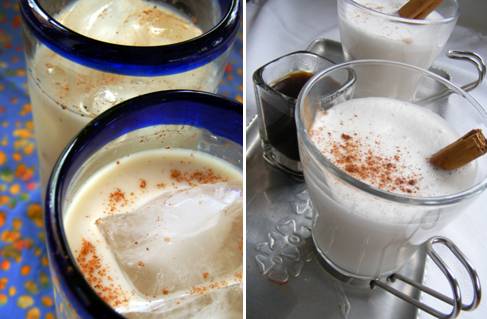
In Mexico and some parts of the U.S., horchata is ubiquitous. The cinnamon-infused rice drink is served cold in huge jars alongside agua de jamaica (hibiscus tea) and other fruit based aguas frescas. This week, we’re also drinking it hot . . .
Despite the unpredictability of spring weather here in Colorado, it’s my favorite of all seasons.
New growth budding on leafless branches. Greener grasses and spring bulbs readying to bloom. Wet snowfalls. Cool weather herbs and greens peeking through in the garden. My first few outings on my bicycle and overestimating how far I could ride. Sore muscles. More snow.
A few days ago we took advantage of 60 degree weather here in Colorado, and cleaned several beds and remnants of seasons since passed. My momma was the willing assistant – helping me carry several tarps full of leaves and turn the compost bin.
That sort of work made us thirsty. Luck (and some pre-planning) was ours, I had three kinds of cold horchata ready to drink. Snap!
As refreshing as it was, we had to fight the urge to drink it all. I still had pictures to take the next day of the “hot” shot – a steamed horchata with a shot of espresso.
A cold blast came through Denver the very next day. Rain quickly turned to snow. And, of course we were out and about in the worst of it. A bit chilled when we got home, we pulled out the horchata again – this time served hot with espresso for momma; steamed and plain for me ( I’m a caffeine wuss).
The hot version, is inspired by Taza de Café, a northwest Denver coffee shop, which serves up horcha-tté, a luscious horchata drink with espresso.
So, horchata is a drink for any season!
Below are 5 ways to make this quintessential Mexican rice drink. Check them out and this song called Horchata by Vampire Weekend, which was released last fall.
Salud!
Tidbits on Horchata:
- In Mexico, horchata is typically made from rice and water, although some make creamier versions using milk and/or almonds. There is also an horchata made from ground melon seeds.
- Horchata, also called orxata, and this method of making refreshing drinks comes originally from Spain, where they use ground seeds, nuts and grains. There, instead of rice, they use tigernuts, also called chufas.
Source: The Mexican Gourmet by Maria Dolores Torres Yzabal & Shelton Wiseman
(more…)
Print & If you liked this post, please share:
Tags: agua fresca, Almond Milk, hot horchata, Latte, orxata, recipe, rice drink, steamer, Taza de Cafe, Vampire Weekend
Posted in beverage, Gluten-free, Mexican, Rice, Vegetarian | 119 Comments »
Sunday, March 21st, 2010
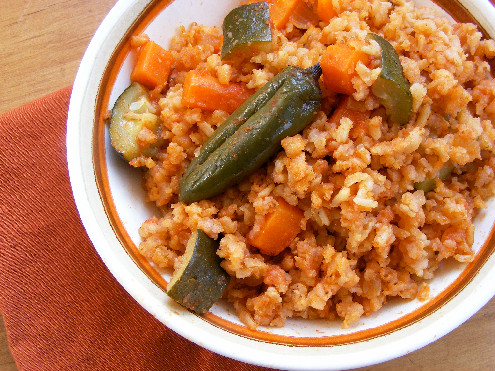
Since my recent post of Mexican rice, arroz a la Mexicana, using long grain white rice (read about the traditional version and its history), several of you have sent me requests for a brown rice version.
I like many of you enjoy brown rice – both for its taste and nutritional benefits. So, I’ve just upped my game by making a Mexican brown rice version.
First though, I have to admit, I’ve attempted this in the past. But, I was less than satisfied with the results – generally involving tripling the simmer time, and the final product lacking texture and flavor. I looked for outside guidance but it fell short – generally, because brown rice is not too common to Mexican cookery.
Yesterday, however, because of your insistence, I finally created a recipe I am very pleased with and glad to share.
I’ve pulled out a few tricks: the rice is pre-soaked to soften the grain; saute the rice for about 10 minutes versus 5 for the white version; and, the rice is boiled for 5 minutes before simmering for 40 minutes (longer boil time and simmer time).
One more thing. I am very familiar with the process of Mexican rice in this pilaf style, so I generally know how to make adjustments such as removing/adding a little liquid; changing the pot to make a larger quantity and using less water for the same. However, if you’re new to it and depending on where you are – sea level or the top of the Rocky Mountains, you may have to adjust slightly.
Let the first attempt be just that. Print this recipe, follow it as is and gauge how it comes out for you. Make notes on how you should adjust next go around.
Happy cooking!
(more…)
Print & If you liked this post, please share:
Tags: arroz a la mexicana, arroz integral, arroz rojo, brown rice, Mexican
Posted in Mexican, Rice, Side, Vegetarian | 11 Comments »
Thursday, March 18th, 2010
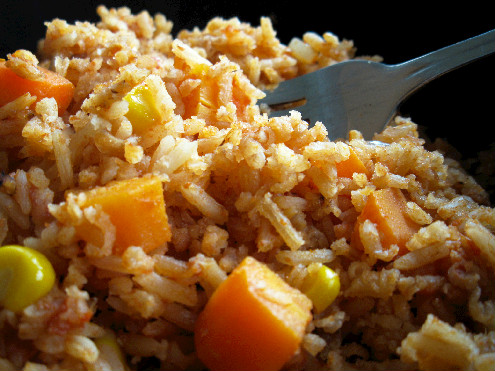
Mexican rice, also called arroz a la Mexicana or arroz rojo, is a requisite when it comes to Mexican food.
In the States, it is a standard side served along with beans. In Mexico, it is one of the most popular sopas secas (dry soups), in a multi-course meal, typically served before the main course.
In case you’re confused, Mexican rice is different than Spanish rice, although some people use the names interchangeably. The Mexican version gets its reddish hue from tomatoes, while Spanish rice generally uses saffron.
Mexican rice was one of the first dishes I learned to cook that required a little skill in the kitchen – sautéing, boiling and steaming. Sounds tricky, but it really just requires keeping a watchful eye on the pot during the sauté.
I’ve been making rice for eons and only recently realized that the technique I learned from my momma, and she from her abuela, was considered a pilaf. In pilafs, the rice/grain is browned in fat before it is simmered in a flavored broth. This cooking process creates fluffy, flavorful rice that’s moist. It also gives it a faint smoky taste from browning.
As you’ll see from the ingredient list and the photos, I add vegetables to my rice. It’s the way my family does it and it’s also the way many in Mexico make it – cocineros add carrots, peas, zucchini and/or fresh whole chiles for flavor. However, if you add peas, promise not to use the canned stuff! Ewww.
Most of the time, I eat this rice with black beans, lots of fresh pico de gallo, and slices of avocado atop. (The pre-cursor to Chipotle’s® bowl.) Others usually eat it as a side dish. Try it with rajas and grilled chicken, caldo de res, mole poblano, and Mexican zucchini – calabacitas con elote.
Tidbits on Rice:
- Rice was introduced to Mexico via the Spanish during colonization via the Spanish trade route from Manila in the Philippines to Acapulco in Mexico. In Mexico, the route is referred to as the Nao de China.
- The length of rice grains should be considered for your desired end result. Long grain rice is fluffy and has separate individual grains after cooking, while medium grain rice clings together a bit more but remains a bit more tender and moist. Short grain rice tends to stick together and is best for things like rice puddings.
Sources: Encyclopedia of Food & Culture; The Art of Mexican Cooking by Diana Kennedy
(more…)
Print & If you liked this post, please share:
Tags: arroz a la mexicana, arroz rojo, best, history, origin, pilaf, recipe, spanish rice
Posted in Main, Mexican, Rice, Side, Vegetarian | 13 Comments »
Thursday, March 11th, 2010
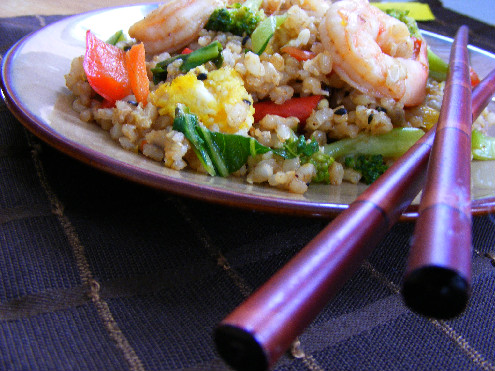
It’s ironic but my favorite five spice mix has six ingredients: Chinese cinnamon, Chinese #1 ginger, star anise, ground fennel, cloves and black pepper.
A quick search online indicates that it’s not all that uncommon and there are mixes aptly named “seven spice.” Supposedly, it’s not so much the number of spices used that’s of import but encompassing all five flavors – sweet, sour, bitter, pungent and salty.
Regardless, the spice mix is what turns this vegetable-laden brown rice dish into a Chinese-inspired main course that’s quick and easy. In China, stir-frys were eaten out of practicality – meat was scarce but rice and vegetables were more plentiful. Stir-frying also conserved fuel by cooking food quickly.
Even though I write this food blog – and put more time into cooking than some – I take advantage of some practical approaches to cooking. For instance, I make one big batch of rice for the week. We’re not huge pasta or bread eaters in our house, so our starchy carb is rice. It’s usually eaten with a lot of soups and beans.
Over the last few months though, I’ve been making fried rice out of leftover brown rice. It’s a go to recipe when I want something substantial without a whole lot of effort. Each time I’ve made it’s been a little of this and that – how I generally cook. I provided measurements just as a guide but hope you make it your own. So, use whatever vegetables you have in the crisper, change out/omit the meat source and even use white rice.
And, one more thing – this is a healthy meal and a good way to eat more vegetables and fiber – despite the word “fried.”
Tidbits on Rice:
- Rice feeds more than half of the world’s population.
- Asia, Latin America and Africa comprise the world’s major rice growing regions. Notably, most rice is consumed within 10 miles of where it is produced.
(more…)
Print & If you liked this post, please share:
Tags: brown rice, budget, Chinese, garden, healthy, recipe, shrimp fried rice
Posted in Asian, easy, Fish/Seafood, Main, Vegetarian | 165 Comments »
Tuesday, March 2nd, 2010
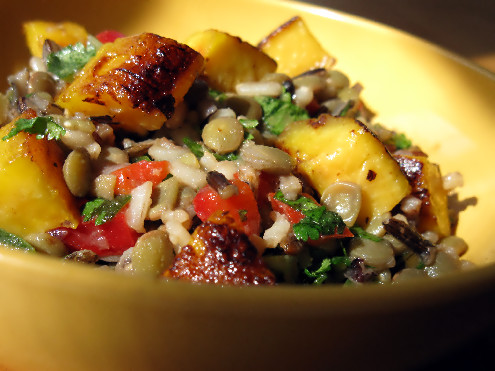
Apparently, lentils and bananas are combined more commonly than we think.
I came upon a Banana-Lentil Salad recipe while browsing Nuevo Latino: Recipes that Celebrate the New Latin-American Cuisine by Douglas Rodriguez, a James Beard award-winning chef. His salad trails back to the Spanish Canary Islands.
In Mexico, as well as in other Latin American and Caribbean countries, lentejas y platanos (lentils and plantains) are frequently eaten as a soup usually stewed with pork. And, in places like Puebla, Mexico, pineapple is also added to the mix, according to The Art of Mexican Cooking by renowned cookbook author Diana Kennedy, who links the savory/sweet combo to Moorish Spain. The combination can also be traced to some African recipes.
This salad recipe, however, is my version of lentejas and platanos. It’s loosely inspired by Rodriguez and traditional lentejas recipes.
If you’re leary about the lentil/plantain combo – have the salad without the plantains, it’s still plenty flavorful and healthy. However, you’re on notice that it’s those platanos fritos (fried plantains) that makes this salad special.
The caramelized plantains have sweet, tender insides that are also a tad bit tangy and a perfect contrast to the crunchiness of peppers, onion and celery, and the nuttiness of wild rice and lentils.
It’s an unusual twist that’s not so unusual.
Tidbits on Lentils:
- Before cooking lentils, be sure to sort the legumes to remove any debris such as dirt and stones. Then rinse well in a colander and drain. It is not necessary to pre-soak lentils before cooking.
- Store unused lentils in an airtight container in a cool, dry location for up to one year.
- Lentils are high in soluble fiber and recommended for people with diabetes and cholestoral problems.
(more…)
Print & If you liked this post, please share:
Tags: Banana Lentil, beans, comfort food, healthy, history, Lentil Salad, recipe, Spanish, unusual
Posted in African, Banana, Bean, Caribbean, Lentil, Main, Mexican, Plantain, Rice, Salad, Vegetarian | 9 Comments »
Wednesday, February 24th, 2010
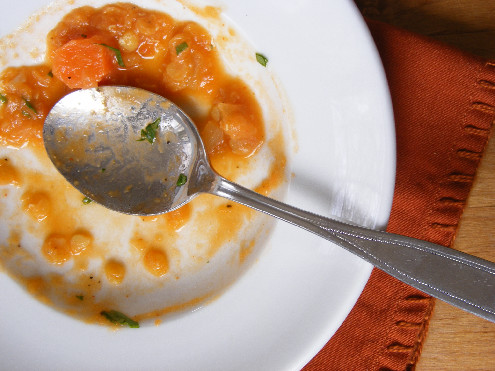
This red lentil soup is comfort food.
It takes the edge off a cold, winter day and satiates my panza (belly).
It’s a souped-up tomato soup – made hearty with red lentils and flavorful with my favorite warming spices: ginger, cumin and chile. Several Ethiopian red lentil dishes are similar; this one is more simple.
Last month, I made a jumbo batch for a New Year’s snowshoe group outing. It was a crowd pleaser. After trekking steep hills in gusty winds at 11,000 ft., we huddled near a fire pit warming cold fingers and toes. And, we grubbed! Hot chocolate, hot ginger tea, home-made sweets, grilled spicy sausage on sticks and, yes, red lentil soup. It was a wonderful way to start the New Year – outdoors, warm and belly full.
Red lentils cook faster than other lentils because they are hulled. Although they are referred to as red, they are actually a salmon pink hue. When cooked, the discs turn golden and are delicate, which makes them well-suited for purées or soups.
This lentil soup is a filling main course especially when served with crusty bread. It’s also a nutritious side dish with a sandwich (or sausage on a stick).
Tidbits on Lentils:
- Lentils’ botanical name Lens culinaris means cooking lens, a reference to its convex shape.
- Up until the later part of the last century, lentils and other beans were generally stigmatized as peasant food – they were staples to those who could not afford meat. However, in places like Egypt, there were aficionados who were particularly fond of red lentils. In India, where vegetarianism was prominent, lentils were also integral to diet.
Source: Beans: A History by Ken Albala
(more…)
Print & If you liked this post, please share:
Tags: budget, cheap eats, comfort food, ethiopian, history, recipe
Posted in African, Gluten-free, Lentil, Main, Side, Soup - Stew, Tomato, Vegetarian | 3 Comments »
Wednesday, February 17th, 2010

Growing up Catholic, lentils were standard in my house every Lenten season. Now, as an adult, I eat them year-round but more frequently during the colder months in hearty soups and other comforting dishes. Although some of you may be scrunching your nose about now, don’t. They make for good eating. Yes, lentils prepared inadequately can be boring and flavorless – perhaps why they get associated with deprivation. But, spiced right, they are oh so scrumptious and uber healthy.
For inspiration on cooking lentils, I look toward India, Pakistan and other countries in the Indian subcontinent, where lentils are integral to diet and dal.
Simply speaking, a dal (also spelled dahl, daal or daahl depending on the specific region) is a stew made from legumes such as lentils and is typically seasoned with turmeric, ginger, and other spices. It is enjoyed with roti (flatbread), fragrant basmati rice, and vegetables.
Traditional dal requires making lentils from scratch. Even though they cook relatively fast compared to other legumes, we’re keeping it simple. Pre-made lentils and a handful of other ingredients (that are likely in your pantry) are all that is needed. This easy recipe is a healthy go-to-meal for those nights when you want something home-made but don’t want to spend hours in the kitchen. It takes about 15 minutes to prepare.
Try this dish as an alternative for a Lenten Friday meal or, if you’re like me, anytime.
Tidbits on Lentils:
- Lentils are believed to have originated from Eastern Turkey and Northern Syria and are thought to be one of the first crops cultivated by man. They have been a food source for over 8000 years, although wild lentils, dating back 11,000 years, have also been found in a Greek cave.
- There are at least 50 cultivated varieties of lentils that come in various forms (split versus whole), various sizes, and an array of colors including yellow, red, green, brown and black.
- Lentils are often considered a good substitute for meat and have gained popularity as a Lenten food. These legumes are a good source of lean protein. They are a complete protein paired with grains, nuts, seeds, eggs and dairy products.
(more…)
Print & If you liked this post, please share:
Tags: dahl, history, india, indian, lent, lenten, origin, recipe
Posted in East Indian, easy, Lentil, Main, Side, Soup - Stew, Vegetarian | 57 Comments »
Friday, February 12th, 2010

Red velvet cake is a Southern classic. It is neither a traditional vanilla cake nor chocolate cake. Yet, cocoa powder is an essential ingredient and the reason why it’s included with my chocolate recipes. That and it’s perfectly gorgeous for Valentine’s Day.
As the name suggests, the cake has a velvety tender texture that is moist and brilliantly red with a subtle chocolate tone. When topped generously with a cream cheese frosting, it makes for a striking contrast.
Instead of a full-on cake, I made cupcakes. They are less formal than a three-layered cake and perfect for sharing with family and friends. Cupcakes were also conducive to cacao nibs – my twist for oomphing up the chocolate factor. It’s not completely traditional but it’s fun.
As for the origins of red velvet cake, the exact history is a bit head-spinning but alluring for foodiephiles . . . Some researchers believe the pinkish-hued chemical reaction that occurs when cocoa powder is mixed with vinegar and/or buttermilk made a precursor cake that was eventually augmented with food coloring. Other researchers point to the rations of World War II, when beets were used to brighten the color of cakes. And, there’s even some food lore involving the Waldorf Astoria and a woman in the 1920s who was billed an exhorbitant amount when she requested their recipe. Apparently, furious, she copied the recipe and distributed it generously. And, still others suggest the cake’s origins are in Canada tied to Eaton’s department store.
Despite all that, I was first introduced to red velvet cake by my husband’s Aunt Gloria. What I remember most about her cake was how lovely it looked sliced and the hint of chocolate and tangy frosting with each bite. She’d make her cake, freeze it and bring it on the plane to Colorado. Now, that’s love. The recipe below is adapted from Aunt Gloria’s family recipe.
Show love this Valentine’s Day . . . Eat chocolate in its many forms.
Tidbits on Chocolate:
- Chocolate has an American annual per capita consumption of around 14 pounds per person.
- Although not true legumes, cacao seeds are frequently called “beans.”
- Typically in the United States, “cacao” is used to refer to the tree and its dried seeds prior to further processing. “Cocoa” refers to the partially defatted, roasted, and ground cacao seeds. “Chocolate” is generally used to refer to a food prepared from roasted cacao seeds. “Cacao nibs” are unsweetened raw pieces of cacao beans, they are crunchy bits that taste slightly nutty with notes of bitter chocolate.
(more…)
Print & If you liked this post, please share:
Tags: cacao, cacao nibs, chocolate, cocoa, cupcakes, red velvet
Posted in chocolate, Dessert, holiday, Soul Food, Southern, Vegetarian | 7 Comments »
Wednesday, February 3rd, 2010
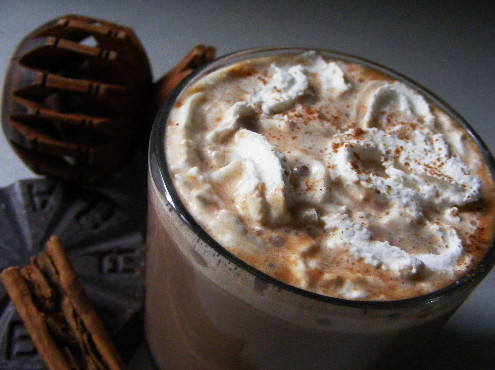
Did you know there are chocolate holidays? May 15 is National Chocolate Chip Day, December 16 – National Chocolate Covered Anything Day (I like this one) and February is Chocolate Month. I am a bit of a chocoholic, so one or two recipes with this featured ingredient won’t cut it. Over the next few weeks, you’ll get several sweet and savory chocolate dishes – just in time for the ultimate of chocolate holidays – Valentine’s Day.
First up is Mexican hot chocolate. It journeys back thousands of years to the Mayas, Aztecs and other Central American Indians. In pre-conquest MesoAmerica, cacao trees were cultivated for many purposes, such as currency, ceremonial, and culinary use. Nobles and warriors drank cacahuatl, a bitter, frothy beverage made from ground cacao seeds, water, vanilla and chile.
Then, upon the arrival of the Spanish, cacao beans were used to make chocalatl, the precursor to today’s sweet hot chocolate. Cacao beans were ground with sugar and other spices such as cinnamon, cloves, anise, and almonds to create a paste that was hardened into tablets. The tablets were then mixed with hot water and corn broth, and made frothy. This sweet version, when taken back to Spain, grew in popularity and eventually spread throughout Europe.
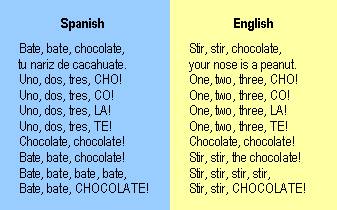
Today, Mexican children often drink hot chocolate with breakfast and they’ve even got a little ditty called Chocolate that they sing as their chocolate is being prepared and frothed.
A brew of Mexican hot chocolate is very simple to make using the Mexican chocolate available in many American grocery stores. The chocolate comes in hard disks and is made of cacao nibs, sugar and cinnamon. It is course and gritty before it is melted, rather than smooth like American bars, baking chocolates or chocolate chips. It can be found in the ethnic food section. I prefer the Ibarra brand, but Abuelita is a good substitute.
I grew up drinking Mexican hot chocolate and, for me, nothing can compare to a taza (cup) of the slightly bitter, cinnamon, chocolate treat.
Bate, bate chocolate!
Tidbits on Chocolate:
- The Mayas and Aztecs made their cacao drinks frothy by repeatedly pouring the liquid from high, back and forth between vessels. Then, the Spanish modeled a molinillo after indigenous whisks to make their chocalatl frothy. Molinillos are available in most Mexican markets and online (see images below).
- Some lore indicates that cacao has aphrodisiac effects and that Motecuhzoma Xocoyotzin (“Montezuma”) drank fifty mugs of chocolate a day, especially before entering his harem.
(more…)
Print & If you liked this post, please share:
Tags: cacao, cacoa, chocolate, drink, history, holiday, Mexican, molinillo, origin, rhyme, whisk
Posted in beverage, Breakfast, chocolate, Dessert, easy, Mexican, Vegetarian | 12 Comments »










